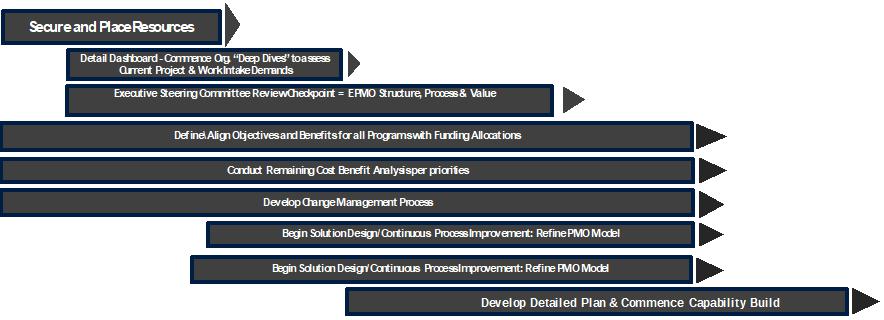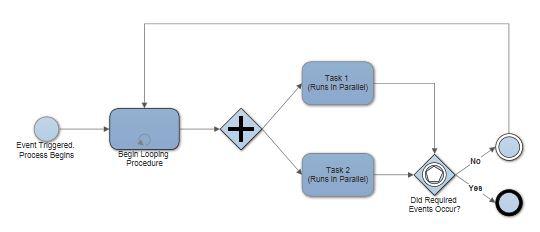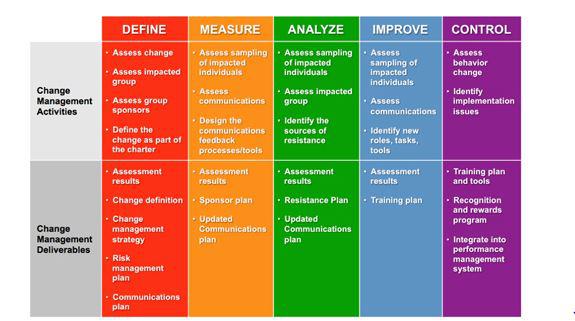Scenario for Activating PMO Capability inside IT
Sample Scenario for Approach:
Outline the steps, for assisting your business or agency in the strategy, design, implementation, and end-user adoption of an enterprise transformation program that will deliver significant results and provide an effective and efficient customer service experience.
For the task requirements listed, break each major task into anticipated sub-tasks or work elements.
Conduct an IT Strategy Assessment of your IT Governance and PMO that would result in an IT Road Map deliverable to set up and activate a functioning PMO capability within IT. The following graphic depicts a high-level approach that SIS would use for implementation of an enterprise transformational program capability.

Task 1: Creation of the YOUR COMPANY Enterprise Transformation Program (ETP)
The key to Synergistic’s success in providing customer satisfaction will lie in the strength of our Project Managers. Never more than one layer away from the executive management of the company, each Project Manager plays a critical and essential role in planning, directing, controlling, and supervising the resources dedicated to a project.
To ensure a thorough understanding of the needs of the client, Project Managers will be brought into the contract cycle as early as possible. Many of the managers who participate in the presentation of corporate capabilities briefs to prospective clients will also play an integral part in responding to requests for proposals from those same clients.
Task 2: Enterprise Business Process Mapping
Conduct and facilitate BPM sessions:
-
Creation of a high level “Discovery Map”, with intent to define the scope, identify team members, and communicate the sponsor’s vision and improvement targets are fundamental activities associated with BPM facilitation sessions.
-
In the BPM facilitation session(s), a key goal becomes documenting the organizations current ‘as-is’ business processes; capturing duplication/redundancies, gaps and inefficiencies. Expected outcomes of such BPM facilitation sessions is to begin developing Process Diagrams, utilizing the creation of “Swim Lanes” which are leveraged to organize the pertinent information to capture the “current state” of the process in more detail. An example of a task associated with this activity is to begin by providing past single instance description(s), which will later be extended to identify significant exceptions that have occurred in relation to the defined instance.
Task 3: Business Process Analysis & Re engineering
Provide an analysis of processes including: gaps, value propositions and recommendations;
-
B usiness A nalysis B ody of K nowledge, or BABOK is a recognized standard emphasizing the focus on business analysis planning and monitoring, which are key requirements supporting effective BPA&R. Through leveraging automated BPA tools such as “ Blueprint ”, which provides automated methods for identifying and documenting “nested” sub-processes, the task of BPA&R can easily be facilitated through “sketching” of, and creation of fully traceable “end-to-end” business processes.
-
Organizations often experience gaps associated with business requirements, and their tangible connection and\or traceability against systems that are developed by the IT Apps. Dev. Organization. This typically occurs within organizations where the Business Analyst function either does not exist, or is lacking within the context of a well-defined Enterprise Governance\Delivery Org. Model. Where this occurs, critical IT development and requirements definition experience in relation to translating defined business processes into deliverable “Use Cases” or business requirements often cannot be accomplished, creating “gaps” in completely defined “end-to-end” business processes.
-
To alleviate this potential gap and begin to experience demonstrable increases relative to the value proposition associated with effective BPA&R planning, management, and monitoring, tools such as Blueprint (See previous discussion above), along with other automated methods, as well as leveraging the BPA role in collaboration with the PMO organization creates sustainable value within the organization. Through development of Business\IT Collaborative Working Groups, and PMO centers of Excellence, where the BPA becomes an integral IT Delivery Steering Committee stakeholder, the role of the BPA becomes recognized across the enterprise as a significant contributor to the quality of what is prioritized and delivered in support of the organizations strategic goals and objectives.
Provide an assessment of capabilities and limitations.
-
Within many of today’s “modern” delivery organizations, Business Analysts may either be internal FTE’s or Consulting resources, of which both typically possess strong backgrounds in either the business or its IT department. Irrespective of backgrounds, there are four critical skill sets that any Business Analyst should possess, as follows:
-
Understanding of the business, its culture, and its domain (e.g., government)
-
Understanding of the principles of information technology, the IT within the organization, and the trends within the field of IT
-
Business analysis techniques and tools
-
Personal qualities and behavioral skills
-
The first is extremely important to business analysis, as business and IT leaders dedicate tremendous time to understanding the organizational structure, its mission, resources, output, and the framework in which it operates (non-profit, government, etc.)
-
Secondly, a strong understanding of IT principles is needed as most business solutions involve IT systems relative to how information technology works (computers, networks, internet, cloud, etc.), system development processes (Agile, DSDM, etc), and trends in technological opportunities for business / government.
-
Thirdly, understanding BA techniques, which include investigation, stakeholder assessment, elicitation, business process and IT systems analysis, requirements gathering, data modeling, facilitation, presentation, project management, change management, and strategic analysis will be critical to the successful administration of the BA function.
-
Behavioral skills are essential for a successful business analyst. These skills can be grouped as inter-personal and analytical skills, both of which will be required to successfully navigate the often diverse Business and IT management spectrum.
Document the envisioned ‘to-be’ business processes (mapped) to the appropriate solution
-
See the Repeatable Business Process Map example below:

The above depicts a simplified example of the output derived through effective BPA&R development and management. As discussed previously, tools such as Blueprint will provide the BPA&R Leader with tremendous accuracy, flexibility, and expediency in developing “end-to-end” BPA Maps across the enterprise.
Task 4: Testing (Functional & User Acceptance)
As part of the Testing Team, assist and/or develop and perform system testing, “use case” preparation;
-
Assisting users through UAT provides the IT organization with a tremendous opportunity to expand on the collaborative activities that are typically championed by the IT Governance leader, in all areas. Users will benefit through understanding the principles and ‘hands-on” application associated with automated testing, test case and test script creation, where ultimately, the QA\Test organization could begin to experience fewer regression testing cycles, and more expedient “Go-Live” production readiness deployments through developing strong and effective UAT collaborative relationships.
Provide pre-UAT training preparation sessions:
-
Consistent with the collaboration benefits expressed above, providing pre-UAT training leveraging forum’s such as YOUR COMPANY’s newly formed “Brown Bag University” sessions, early test planning and preparation sessions help to ensure full “Life-Cycle” test delivery, in alignment with the overall SDLC, as well as potentially accelerate testing schedules, which benefits projects where DEV activities extended beyond their targeted project delivery task completion dates.
Deliver UAT
-
UAT often is modeled leveraging the “Use Cases” that were modeled against the “System Testing” criteria. While “System” testing evaluates the performance and functionality of the to-be-delivered “System” from an end-to-end perspective, UAT can target specific “Modules” or specific performance “Functionality” associated with an end-users job function, or specific focus\emphasis on a unique system capability. In this regard, the collaborative tasks and anticipated benefits discussed under “assist and/or develop and perform system testing “Use Case” preparation” are equally applicable in support of providing UAT assistance to end user groups.
Task 5: Training Design, Development & Delivery
Provide training plan strategy;
-
Training plans\strategies are designed based on the specific subject matter being presented, coupled with the expertise of the SME conducting the specific training. A guide to determining various training methods\approaches is provided as follows:

Determine and develop training curriculum including: written materials, user manuals and class-room materials;
-
The Governance organization should encompass technology support functions, notably: Technical Writing – Quality Assurance – Business\Technical Analysts, and Communications\Change Management personnel, all of which are to be leveraged in the development, curriculum design, and production of training materials to be utilized within the organization.
Develop, document and deliver training for all end-users, all user access positions;
-
Identical to the information above, coupled with the tightly-collaborative integration of the business analyst position, which ensures business specific requirements, process management “jargon”, and other business factors are appropriately integrated into developed training materials and curriculum(s).
Develop and facilitate train-the-trainer sessions;
-
Typically, in regard to various training sessions facilitated by and\or for the Business and IT organizations, highly experienced SME’s, preferably with training experience are selected to facilitate various trainings, as well as partner with identified training participants, typically leveraging a proficiency scoring process to assess the effectiveness of “train the trainer” approaches to knowledge transfers into various functions across the enterprise. While proven effective, pre-requisites typically involve ensuring domain specific training is presented to those within their specified professional or business domain skill\knowledge area. (Ex. Dev training for Developers. QA\Training for QA\Test\or UAT personnel, etc.)
Develop and administer processes to evaluate staff performance and assess staff operational readiness, i.e., exams, pass/fail, progressive testing, etc.
-
Development of various scoring methods to assess training effectiveness is a key responsibility of the training organization, or the internal organization that will be the benefactor of any “train-the-trainer” activities. Multiple methods for evaluating training effectiveness exist, with five of such presented below as examples:
1. Satisfaction thru Participant Reaction to the Training
2. Knowledge Acquisition - Determined thru an Exam following the training.
3. Measureable Business Improvement – Measured through objective KPI’s and other “scoring” criteria.
4. Behavioral Application – Identification of targeted behavior changes that are anticipated as a result of the training.
5. ROI – Identifying the specific “Value Proposition” thru pre-determined ROI (Return on Investment) measurement criteria.
Task 6: Change Management & End-User Adoption (EUA)
Develop enterprise organizational readiness plan;
-
Organizational Readiness Planning at an enterprise level is established to assess the organizational culture, along with other indicators and factors structured to determine how ready an organization is for radical changes relative to how it does business, both present and future state. To achieve this goal, an organizational readiness assessment should be created by the PMO. The assessment should be designed to clearly identify stakeholder perceptions toward change, value proposition alignment, and whether the are ready to proceed. Minimally, the following four steps should be undertaken by the PMO in developing the EORP.
1. Conduct structured interviews with key stakeholders.
2. Distribute questionnaires to a cross-section of the organization.
3. Collect and synthesize data.
4. Provide feedback to the participants.
Determine and develop training curriculum including: written materials, user manuals and class-room materials;
-
Comprehensive Enterprise Communications Planning and subsequently developed Communication Plans help foster acceleration, as well as acceptance of change, coupled with being an essential, critical tool for use by the CIO and other IT and Business leaders. As leaders begin with the basics (who, what, when, why, where, the primary foundational framework for any enterprise change management process), assume that the target audience will not necessarily “connect the dots” regarding the value proposition associated with the change. In this regard enlisting the PMO\EPMO’s Change Management organization to develop meaningful, impactful communication plans that clearly convey the “value proposition” regarding why the change is being initiated, as determined by the specific “Context” of change that is being driven within the organization is a critical component and measurable success factor for the Governance organization. The simplified example depicted below, utilized by our SIS Governance Practice at multiple client engagements, represents a comprehensive Lean/Six Sigma approach to Enterprise Communication Planning. At a programs implementation level, within each stage there are definitive, pre-planned change-management activities and deliverables along with other contributing, defined project-management activities and deliverables consistent with SDLC and SQLC methodology management.

Governance Change Management Processes and associated Stage Gates
When implemented within enterprise-wide initiatives, different SME’s and\or different teams manage this process activity from end-to-end. In smaller initiatives, it is highly feasible that one highly skilled technology \ business focused SME performs multiple roles.
( Note : Change Management is a broad term, that can be categorized into 3 core “Contexts”:
First Context : Change management refers to managing changes to artifacts, such as code changes or documentation changes, all of which must be “Change Managed, or “Version Controlled” leveraging the organizations approved ITSM, and or S/W DEV or QA process management tools.
Second Context ; The process required for implementing an organizational change, such as communication processes that are aimed at gaining acceptance from stakeholders and those people affected by a change at an “Enterprise” level.
Third Context : The third context is the discipline that's used in IT Service Management (ITSM) as applied to highly controlled change processes.
As there are three primary “contexts” associated with Change Management, the role of an effective PMO will be to ensure that adaptations can be facilitated seamlessly to properly reflect important updates, articulate delays, or shift responsibilities as necessary altogether, recognizing resistance is in itself an aspect of any enterprise change management function that must also be objectively and effectively managed. A sample illustration of a
Develop and deliver commission-wide informational sessions, including external;
-
Executive leadership informational sessions will be delivered as required, leveraging the various Executive Meeting “Cadence’s” that will be established by the EPMO, in collaboration with the executive leaders within YOUR COMPANY that will comprise Executive Steering Committee membership. Such sessions will be facilitated through multiple communication channels, including but not limited to the following:
1. Executive Steering Committee Scheduled Information Update Meetings
2. Executive Management Functional Organizational Meeting Participation
3. Targeted “Executive Brown Bag University” Education Sessions
4. Enterprise Program Management Activity Update Documented Communications
Develop supplemental web-based training (WBT)
-
Typically, in regard to various training sessions facilitated by and\or for the Business and IT organizations, highly experienced SME’s, preferably with training experience are selected to facilitate various trainings, as well as partner with identified training participants, typically leveraging a proficiency scoring process to assess the effectiveness of “train the trainer” approaches to knowledge transfers into various functions across the enterprise. While proven effective, pre-requisites typically involve ensuring domain specific training is presented to those within their specified professional or business domain skill\knowledge area. (Ex. Dev training for Developers. QA\Training for QA\Test\or UAT personnel, etc.)
Develop and administer processes to evaluate staff performance and assess staff operational readiness, i.e., exams, pass/fail, progressive testing, etc.
-
Web-based training will be consistently championed by our PMO\EPMO organization, and developed in collaboration with YOUR COMPANY’s internal Applications Development and Communications teams. Web-Based training will be facilitated through content access via intranet links within the “Education” tab being developed for the internal PMO\EPMO Intranet site. In essence, every educational and\or instructional educational component developed by any CIO. approved PMO\EPMO core competency organization will be accessible via SharePoint (Initial Access), with intent to evolve to the PMO\EPMO Intranet Site. Access to delivered training materials, whether internally developed, or provided through external vendors is intended to be available thru the YOUR COMPANY PMO \EPMO Intranet EDU “Tab” or “Link”, once developed.
C. Sample Performance Measures:
% tasks yellow or red
-
To be reported to internal YOUR COMPANY Exec. Leadership via weekly and\or bi-weekly PMO \ EPMO meetings, via the use of various program Dashboards, Project Status Updates, and other tools recommended by PMI – PMBOK reporting standard practices.
% projects completed on approved schedule
-
To be reported monthly \ quarterly within the fiscal calendar, leveraging actual Project Management Plan data. Additionally, project delivery success stories should be pro-actively and aggressively marketed throughout the enterprise, in collaboration with our internal Communications Management team.
Due vs. Done ratio
-
Consistent with “% projects completed on approved schedule”, metrics specific to Due Vs Done ratio (Also “Planned Vs Actual) will be managed and reported by the PMO \ EPMO on a monthly \ quarterly cadence, as determined by the Executive Steering Committee and the direction of the CIO, respectively.
% quarterly milestones on schedule
-
Same as above.
Schedule a Free Consultation
We help global leaders with their organization's most critical issues and opportunities. Together, we create enduring change and results.

Super Efficient

Deeply Committed


